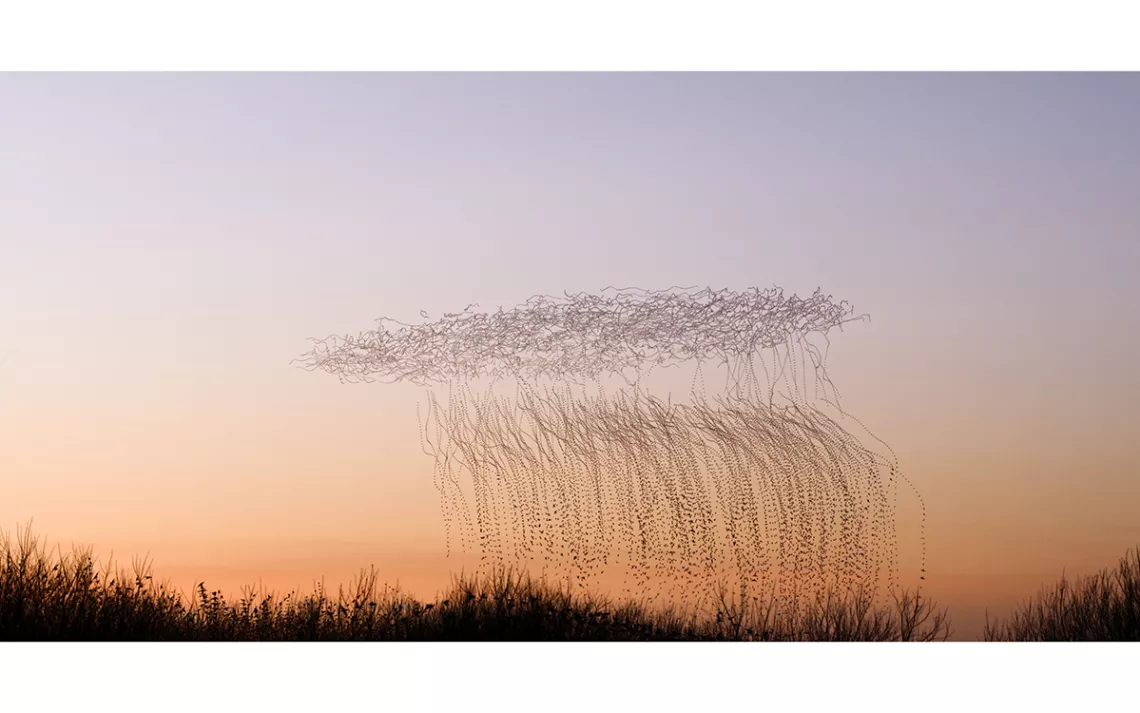Starling-Studded Skies
Physicist-turned-photographer Kathryn Cooper uses chronophotography to study the murmurations of starlings
Photos by Kathryn Cooper
At first, they trickle in: one bird here, a few birds there.
Then, at dusk’s cue, a dark smudge materializes on the horizon. Thousands of starlings (Sturnus vulgaris) slowly come into focus, etching flight paths across the winter sky as they stream toward their evening roost in north-central England. Suddenly, the flock dips and twists like a horse tossing its head. It swirls into a funnel, then cartwheels to the side, shapeshifting in seemingly effortless unison. All the while, the birds’ feverish wingbeats and raucous chatter reverberate through the air—and reveal why this intricately coordinated performance earned its name: a murmuration.
Each winter, starlings gather in large flocks of up to 100,000 individuals across the United Kingdom. Most have migrated from northern Europe, seeking milder temperatures and more abundant food. Their arrival is celebrated by residents outside the city of Sheffield, England, where restored wetlands offer prime roost habitat and where vast horizons make a perfect theater for evening murmurations. Among the routine spectators is Kathryn Cooper, a physicist turned photographer who sees more than just a mesmerizing aerial display. Trained in bioinformatics, Cooper has a keen eye for understanding complex data. “I’m interested in the transient moments when chaos briefly changes to order and thousands of individual bodies appear to move as one,” she says.
Cooper has endured more than 50 cold and wind-whipped evenings in patient pursuit of such fleeting moments. Over the past four years, she’s also refined a modern approach to a 19th-century technique called chronophotography: assembling a sequence of images to study motion. To illustrate a particular piece of murmuration choreography, Cooper first films the starlings in 4K resolution. Then, working with clips that range in length from less than a second to more than a minute, she designs algorithms that help her select and splice together a compelling set of frames. “It’s really fascinating to be visualizing [the murmuration] at the same time that people are researching it,” she says.
While murmurations are a well-documented phenomenon, scientists are still working to understand why they occur. One hypothesis suggests that starlings murmurate to advertise the evening’s roost to stragglers, since bigger roosts offer more warmth. But a 2017 study found that predation pressure is a more powerful driver; in a sample of more than 3,000 murmurations, the presence of predators was positively correlated with both murmuration size and duration. Large flocks don’t just benefit from increased vigilance. Their complex flight patterns also prevent predators from honing in on a singular target, increasing the odds of survival for each starling in the flock.
Despite their seeming ubiquity, starling populations have declined in the United Kingdom by approximately 70 percent since 1980 due to the loss of suitable roosting and feeding grounds, including wetlands and meadows. But habitat restoration projects are helping to reverse that trend. The nature reserves where Cooper captured these images were once home to coal mines and quarries, their only soundtrack the rumbling of trucks and mining machinery. Today, these restored wetlands sing with the buzzing of bees and beetles, the mating calls of bitterns and other wading birds, and, each winter, the hum of murmurations as starlings dance across the skies.
 The Magazine of The Sierra Club
The Magazine of The Sierra Club















